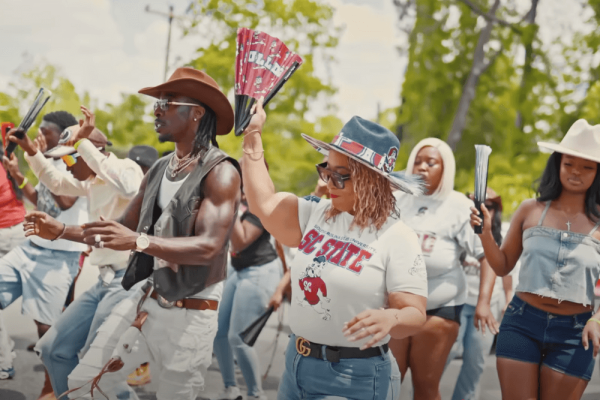I didn’t expect church to be the place where I learned 803Fresh’s “Boots on the Ground,” the latest line dance taking the nation by storm. The song, which currently has more than 14 million views on YouTube and is known for the refrain, “Where them fans at,” has been danced to by folks like Shaquille O'Neal, Ciara, Kamala Harris, Tina Knowles, and Michelle Obama. And it’s been performed everywhere, from trail rides to graduations, news broadcasts to talk shows. But when people started performing the line dance in church, not everyone was pleased.
“Some of these so call [sic] churches is night 🌙 clubs,” wrote one Facebook user in response to a viral video of a “Boots on the Ground” line dance performance at a small church. “Put them boots on the PASTOR and scoot him out of the church,” another wrote.
Needless to say, I was interested in seeing how the special line dance performance would be received at the large Black Southern church I was attending.
As members of our church’s dance ministry and mime ministry, we were used to dancing and moving at church, but only in the context of praise and worship. However, this was a special event. It was the pastor’s anniversary and the goal was to have fun and to get the congregation moving with us. Because we were at church, we removed the vocals from the track to censor any lyrics that could be interpreted as inappropriate. We also modified our movements, minimizing the shaking of our hips. But we kept the most important element: the fans. As we danced, roughly one-fourth of the people present joined us, many bringing their own fans. It was a moment of joy and celebration as a church family.
The relationship between dance and the church is a complicated one, marked by both repression and resistance. It has been shaped by Western perspectives rooted in racism, sexism, and colonialism, as well as the demonization of bodies, sexualities, and pleasure—especially those of marginalized communities. I was brought into this complicated history through my doctoral research, which explores how Black women cultivate the sacred through dance in religious forms such as liturgical dance, and in forms and spaces not typically understood as “spiritual” or “religious.”
While liturgical dance is welcome in many places today, there was a point in time where even dance in service to God during the worship service was stigmatized.
In Dancing in the Streets: A History of Collective Joy, Barbara Ehrenreich traces a history of Western perspectives on dance, addressing its overlap with the history of the Christian church.
READ: The Gay Minister Who Inspired Lady Gaga’s ‘Born This Way’
Dance was a common practice during the early days of Christianity. As drums and music played, people moved their bodies spontaneously and feverishly in ecstatic worship. Christianity was a spiritual practice in which the Spirit of God moved in eating and communing, in speaking in tongues, and in singing, dancing, and making music together. This continued into the first and second centuries of the church.
However, when Christianity became the official religion of the Roman Empire, the church began to condemn dance. The Christianity of the early church, characterized by its care for the poor and marginalized, social solidarity, and lack of hierarchies, was perceived as a threat to the status quo and to empire, so its ecstatic practices were no longer tolerated. It was deemed uncivilized and irrational. As such, Christianity had to evolve, and rituals and practices like dance and speaking in tongues were suppressed.
“The early Christian patriarchs may not have realized that, in attempting to suppress ecstatic practices, they were throwing out much of Jesus too,” Ehrenreich writes. Dance, once sacred, became secular, and dancing bodies were cast as bad, sexual, sinful, and demonic. John Chrysostom, the archbishop of Constantinople, said of it: “For where there is a dance, there also is the Devil.”
The early Christian patriarchs may not have realized that, in attempting to suppress ecstatic practices, they were throwing out much of Jesus too.
This perspective shaped how the movement of enslaved Black bodies in the Americas was perceived. In Dancing Many Drums, P. Sterling Stuckey writes about the relationship between dance and Christianity for African Americans. African people brought their music and dance practices to the Americas. Dance was a place of release, an embodiment of freedom amid enslavement. Dance allowed them to embrace the sacred and the spiritual in the everyday. Stuckey writes: “In fact, dance was the principal means by which slaves, using its symbolism to evoke their spiritual view of the world, extended sacred observance through the week.” Nevertheless, white enslavers tried to restrict dance because they deemed it sexual and primitive.
Christians who condemn line dancing in churches have adapted this Western colonized perspective that robs dance of its sacredness. And yet, leaning into an African cosmology invites us to live into the both/and, to free ourselves from the dualism that divides the sacred from the secular and fractures us into bifurcated beings.
One way to reclaim dance as sacred is by embracing Southern soul music like “Boots on the Ground.” The Southern soul genre is often described as a mix that include gospel, blues, country, R&B, funk, and soul music. It is a genre that is Southern born and bred. Southern soul music challenges the division between the sacred and secular, embracing the entirety of the Black experience. My introduction to Southern soul came through my maternal family in Henderson, N.C. Growing up, I’d see my grandmother two-stepping with my cousins at family gatherings to songs like Mel Waiters’ “Got My Whiskey” and “Hole in the Wall.” This was Black joy and celebration. These were sacred familial and communal encounters.
The singer of “Boots on the Ground,” 803Fresh, describes Southern soul music as “feel-good music.” He shares that what he loves about Southern soul is its ability to bring people together. 803Fresh grew up in Wagener, S.C., singing in the church choir, like many Black people who grew up in the South. In many ways, the Southern soul genre is a return to his roots, our roots, roots that embrace the sacred in the everyday. In an April 2025 interview with The Breakfast Club, 803Fresh shared that Southern soul provided him with a feeling that he didn’t find in pop, R&B, or rap, and it pulled him through some personal struggles. “Then I found Southern soul. Really Southern soul found me. It actually saved my life, man.”
As Southern soul, “Boots on the Ground” promotes healing, communal solidarity, and Black joy. It strengthens our spirits. It celebrates the God within us.
Everything that has been said about line dancing in churches was also said about liturgical dancing in churches. And yet, churches have grown to accept and appreciate the ways that God can move and speak through our bodies during the worship service. I would offer that perhaps liturgical dance and line dance aren’t so different, that every time we come together in praise, celebration, joy, and dance, we bring glory to God. This is true whether we’re at the church, at the trail ride, or at the family reunion.
Our dance is a celebration of the sacredness and divinity that is found in our Black bodies everyday. It is a reclamation of our movement, beliefs, and cosmologies that were once condemned and restricted. Our dance is an embodiment of the freedom that is found when we liberate God—and our Black churches—from the shackles of Western Christian hegemony, anti-Black racism, sexism, and colonization.
Got something to say about what you're reading? We value your feedback!







